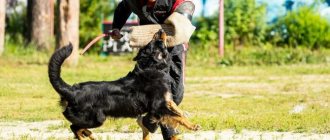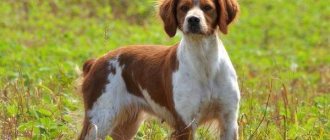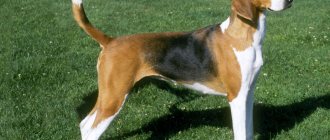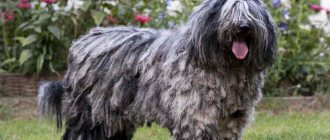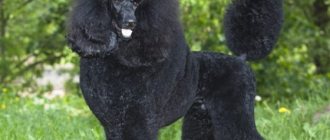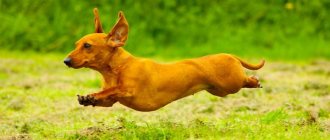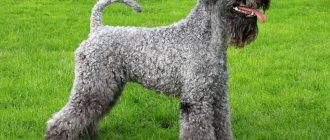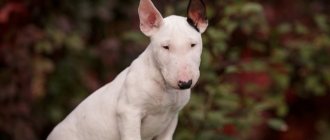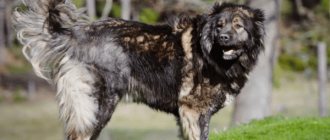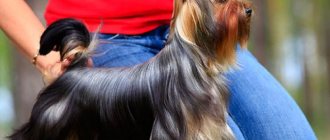History of the Miniature Pinscher breed
Miniature Pinscher
pinscher, also known as the dwarf or miniature pinscher, is a breed whose development began at least two centuries ago in Germany. Experts have no doubt that the dominant role in the development of the breed belonged to short-haired German pinschers - dogs known in Europe since the Middle Ages. They were famous for their unpretentiousness in maintenance and their versatility: they served as guards on farms, had a reputation as excellent hunters and dexterous rodent exterminators. In addition to German pinschers, among the distant ancestors of miniature pinschers, dachshunds and Italian greyhounds are also called - the shortest dogs of their group of greyhounds.
It is known that at the beginning of the 19th century, the height of a standard pinscher was from 45 to 50 cm at the withers, and their miniature varieties, which already in 1936 were called dwarf smooth-haired pinschers, were characterized by a height of 35 to 40 cm.
In the second half of the 19th century, targeted selection of pinschers began, and in 1880 the first official breed standard appeared, developed by the German dog handler Richard Strebel. Five years later, German breeder Joseph Bertha founded the Pinscher Club, under the auspices of which pinschers of different appearances were divided into separate breeds.
Miniature Pinschers were first shown at the Stuttgart Dog Show in Germany in 1900. At that time, outside their homeland, these dogs, nicknamed miniature pinschers for their small stature (“zwerg” translated from German as “gnome”), were practically unknown. However, over time, the breed began to gain popularity both throughout Europe and overseas. In 1905, the first Miniature Pinscher was registered in the French Stud Book. True, he was described as a German smooth-haired terrier. In the USA, where the Miniature Pinscher began to be imported after the First World War, the breed was also originally included in the terrier category. In 1929, when the American Kennel Club (AKC) officially approved the Pinscher breed, the Miniature Pinscher Club was created, whose members petitioned for the AKC to classify their smallest species as the "Pinscher (Toy)" group. In 1972, the name was changed to "Miniature Pinscher".
These days, this small but brave dog has a lot of fans in all corners of the planet. In different countries, it is often called differently in everyday life and when sold, but since 1955, in the classification of breeds of the International Canine Organization (FCI), the smallest representative of pinschers is called a miniature pinscher.
Mating
According to standards, a miniature pinscher female is allowed to breed no earlier than 15 months. Pregnancy lasts 63 days. No significant changes in behavior are observed. Repeated mating can occur after 1-1.5 years, when the mini pinscher girl gains strength, gets stronger and recovers. The last mating occurs at 8 years of age. Frequent childbirth exhausts the dog and significantly reduces life expectancy. During pregnancy, you need to take care of your dog as before, be sure to take walks and monitor its diet. This allows you to train the expectant mother before giving birth.
Appearance of a miniature pinscher
Miniature Pinscher puppy
Today at international exhibitions you can see miniature pinschers belonging to different intra-breed types. This is explained by the fact that the breeding of these dogs in many countries is based on their own traditions in the selection of this breed. Thus, dogs bred in the USA, Great Britain, and Canada are characterized by a special, graceful manner of movement. Miniature pinschers, originally from Israel, are distinguished by almost absolute external similarity with miniature Doberman Pinschers; they are characterized by confident, wide, sweeping movements. German natives can always be recognized due to their stockiness and muscularity, and representatives of Scandinavia are the most balanced, calm and self-confident individuals. However, for all miniature pinschers there are strict limits for height (25-30 cm), colors, and a certain body structure.
Frame
The Miniature Pinscher is distinguished by its high legs, but the well-developed withers, which are the highest point of the topline, give its body depth, so the dog does not look upturned on its legs. The line of the back is slightly inclined from the withers to the base of the tail. The chest is quite wide, oval in shape, its front part protrudes expressively forward. A short, elastic and strong back, a strong and also short loin give the miniature pinscher a compact appearance, while its body looks almost square.
Head
The dog's head is proportional to the body and has the shape of a blunt wedge. The transition from forehead to muzzle is clearly marked, but not sharp. The muzzle itself is slightly shorter than the skull, which is strong and oblong in shape. The bridge of the nose is straight. The nose is black, the nostrils are well developed. Lips are dry, smooth, black. They fit tightly to the jaws, their corners are closed.
Jaws and teeth
Miniature pinscher black and tan color
The miniature pinscher's jaws are strong, the teeth are white, strong, the bite is scissor-shaped, closing tightly and firmly. The chewing muscles are well developed.
Ears
The Miniature Pinscher's ears are set high. Standing or hanging on cartilage, they have a triangular (V-shaped) shape. The inner edges of the floppy ears should touch the cheekbones. The standard does not say that cropped ears are a breed fault, however, in countries where there is a ban on ear cropping, dogs subjected to this procedure are not allowed to participate in shows and championships.
Eyes
They are small in size, oval in shape, and their color is dark brown. Black eyelids fit tightly to the eyeball.
Neck
This part of the dog's body is characterized as dry, without dewlap, slightly elongated. It is nobly curved, which emphasizes the proud character of the miniature pinscher.
Miniature Pinscher muzzle
Tail
Miniature pinscher fawn color
The tail of the miniature pinscher is set high, but cannot be directed towards the head. At dog shows, judges tend to favor dogs whose tails are saber or crescent shaped.
Limbs
They are characterized by clearly defined angles of all joints and a moderately wide stance. The forelimbs look straight in front and in profile. The forearms are well developed, muscular, the wrists and pasterns are strong, strong, and elastic. The hind limbs, when viewed from the side, appear slightly set back, and when viewed from behind, they appear parallel to each other. The hips are quite wide, with well-developed muscles. The lower legs are long and strong. The miniature pinscher's paws are round in shape, the fingers are closed, the claws are short, strong, and painted black. The hind legs are slightly longer than the front legs.
Movement
The Miniature Pinscher moves energetically, demonstrating confidence and strength. It is characterized by a free, sweeping trot with a strong drive and a wide reach of the forelimbs. While moving, the dog balances, its back remains level and stable.
In countries such as the USA, Great Britain, Canada, the most important natural feature of the miniature pinscher breed is its prancing gait (hackney-gait). This specific feature is characterized by the fact that the dog seems to be drumming on the air with its forelimbs. Such a gait appears only when the shoulder angle is straightened, as a result of which the step of the front legs becomes much shorter than the step of the hind legs, which forces the dog to raise the front legs high in movement so as not to step on them with the hind legs.
But FCI standards do not recognize this type of movement and classify it as a breed defect.
Wool
The miniature pinscher has a thick, shiny, smooth coat. Bald patches are not allowed.
Color
Miniature Pinscher in profile
Today, the FCI standard allows only two colors for the Miniature Pinscher: fawn or fawn (from reddish-brown to dark red-brown) and black and tan (lacquered black with red or brown markings). The scorch marks should be intensely dark and clearly defined. They should be distributed in a certain way: above the eyes, in the lower part of the throat, on the pasterns and paws, on the inside of the hind legs, under the base of the tail. Two identical, clearly defined tan marks in the shape of a triangle should be located on the dog's chest.
American and Canadian cynological organizations also recognize other colors of miniature pinschers: chocolate, blue, isabella and tan.
Disadvantages of the breed
- Too heavy or, on the contrary, too graceful physique.
- Long, soft or hunchbacked back.
- Short-legged or excessively tall-legged, elbow joints protruding inward or outward.
- Wrinkled skin on the forehead.
- Shortened or pointed, too narrow muzzle.
- Excessively small or too large eyes, their light color.
- Long or low-set ears.
- Rare wool.
Kinds
Breeders of each country make minor adjustments to the standard of this breed. For example, American Pinschers are the most muscular. They are a little larger than the others. But the Russian representative of the breed has a drier build.
Recently, a variety of mini pinscher was bred in Israel. In appearance and character, this dog is very similar to a Doberman. It is 3-4 cm smaller than the standard one, and its weight does not exceed 4.5 kg.
All varieties of pinschers differ little from each other in coat structure and colors. Two color options are allowed: fawn and red-black. It is important that the red and black individuals have symmetrical light markings on the chest, ears and face. The dog's fur should be shiny.
Photo of a miniature pinscher
Character of the miniature pinscher
The miniature pinscher is not at all bothered by his small size - he is so self-confident and courageous. Incredible aplomb and energy, combined with intelligence and cunning, allow this little guy to become a key participant in all the events happening around him - at home, on the street, at an exhibition, that is, everywhere.
Miniature Pinscher with Doberman
The miniature pinscher shows his love and devotion to his owner very emotionally, and at the same time prefers to feel on an equal footing with him. This dog needs a “steady hand”, otherwise an innate passion for dominance and manipulation will certainly manifest itself. If this cunning, irrepressible imp understands that by putting on a plaintive look he can get whatever he wants, then there will be no limit to his extravagance. This dog will demonstrate its desire to occupy the highest possible position at every opportunity, both in relations with people and when communicating with its fellow tribesmen, even the largest of them. To avoid problems, your miniature pinscher should be taken for walks on a leash.
The dog is aggressive towards small animals, especially rodents and birds; he does not favor cats either. Peaceful coexistence between miniature pinschers and representatives of the cat family is possible only if the pets were raised together from a tender age.
Incredibly agile, with excellent grip, strong teeth and lightning-fast reactions, the miniature pinscher feels like a family protector and watchman. If someone decides to harm his owners, the dog will rush at the potential enemy before he has time to carry out his plans. At the same time, the miniature pinscher’s nervous system is strong, and his courage is not reckless - he always soberly assesses the situation and his strengths.
The miniature pinscher is constantly overwhelmed by a thirst for activity; he is incredibly inquisitive, inventive, observant and, like a detective, is always ready to investigate. If the dog wants to carry out a certain undertaking, he will find a way to escape from anywhere, overcoming all obstacles in an unimaginable way. He can easily climb onto a table, a window sill, or crawl into the narrowest crack. His tricks amaze with their creativity, and his ability to perform various dizzying stunts suggests that he clearly likes the role of a clown: the laughter and attention of his household is a true reward for him.
Miniature Pinscher with his owner
Miniature Pinscher with a cat
Some interesting facts
- The Miniature Pinscher is not a dog for beginners.
- The miniature pinscher loves games, regardless of where they are played: indoors or outdoors. The Pinscher does not need active exercise; an evening walk may be quite enough for the normal development of your pet.
- It is better to keep these dogs in families where the children have reached older ages. The Pinscher's character is somewhat aggressive if something does not go as the animal would like it to. Therefore, the Pinscher can harm a small child.
- A miniature pinscher can have docked ears and tail, or live with an undocked tail and ears, there is not much difference in this, it all depends on the owner himself.
- The color of the pet can be red, red interspersed with black hair, black with reddish interspersed, chocolate and fawn.
- The Miniature Pinscher does not tolerate low temperatures well. In the cold season, he needs to be dressed in warm clothes.
- Since miniature pinschers were bred to hunt rodents, they can attack small animals that the dog would perceive as prey.
- Miniature Pinschers are very active dogs.
- Miniature Pinschers are very active and very curious. To raise them properly, the owner must have a persistent character and leadership qualities.
Video
Education and training
Endowed with intelligence and quick wit, the Miniature Pinscher is easy to train. However, the owner must take raising a pet very seriously, taking into account the characteristic features of this breed: the dog will not miss the opportunity to quietly establish its own control over the training process if the owner makes even the slightest mistake. Showing excessive love and forgiveness when raising a miniature pinscher is unacceptable, just like rudeness.
Walking the Miniature Pinscher
Training techniques should be based on the principles of consistency and repetition, so teaching a miniature pinscher discipline, obedience and good manners takes longer than working with most other breeds. The dog must understand that the owner is calm, self-confident and firm in his intention to teach him order - in this case, with the zeal of a true careerist, he will demonstrate his readiness to serve and carry out commands.
The miniature pinscher masters the equipment on the training ground with amazing agility and speed, and it is not difficult for him to overcome an obstacle five times his height from a standing start. Such abilities, combined with excellent maneuverability, make the Miniature Pinscher one of the best breeds that demonstrate outstanding success in agility.
Childhood, youth, maturity, old age
There is a conditional coefficient used to compare a dog's age with a human's - it is suggested to multiply the years a dog has lived by 7 to determine the stage at which it is. In terms of development, a puppy corresponds to a child, and a 16-year-old dog corresponds to a very old man. For example, if a miniature pinscher has been living , we can say that your friend is about forty-five by human standards. This ratio is only suitable for approximate calculation of the age of an adult dog, because in the first years of life the body develops at a rate that is 2-3 times faster than subsequent growth and aging. For example, a one-year-old Doberman is no longer a seven-year-old child, but a teenager who has reached puberty.
Important! Veterinarians recommend regularly examining your dog, starting at the age of five. This will help to identify possible diseases in the early stages and treat them quickly, with minimal interference in the body’s functioning.
Care and maintenance
The miniature pinscher is a companion dog, so he certainly must live under the same roof with his owner; keeping the animal in an enclosure is absolutely unacceptable. The dog himself will feel great both in a city apartment, even a small one, and in a country house: he will always figure out something to do with himself and will not be bored. Owners of a miniature pinscher should understand that their irrepressible pet must have the opportunity to realize its activity. Otherwise, his energy will take on destructive forms, and the calm atmosphere in the house can be forgotten. A “city dweller” dog needs to be walked at least three times a day, and it is advisable that he has the opportunity to frolic without a leash in some suitable place.
When walking a miniature pinscher in bad weather, the owner must take some points into account. Frosts, for example, are not scary for this short-haired dog, provided that it is constantly on the move. But if during a walk the dog is caught in cold rain or sleet, you need to pick him up, cover him with whatever you have, take him home and dry him thoroughly, otherwise he may not only catch a cold, but also get kidney and genital diseases. Caring owners, as a rule, purchase seasonal clothing for their miniature pets - waterproof and windproof overalls.
Miniature Pinscher in a warm jacket
Despite the fact that miniature pinschers shed periodically, caring for their coat will not be burdensome. It is enough to comb the dog preventively once a week with a special soft brush for smooth-haired dogs; it would also be a good idea to periodically wipe its fur with a damp natural cloth. You can give your pet a general wash if it has gotten pretty dirty in its adventures.
The dog needs to have its teeth brushed two to three times a week, and its nails trimmed once or twice a month.
So what are we having for dinner today?
The miniature pinscher's appetite is quite moderate, but in the cold winter the dog, as a rule, begins to show remarkable interest in food, since it needs more energy. During this period, many dogs gain excess weight, which is highly undesirable. Owners should not change their pet’s usual diet, but adding foods with a high protein content to it would be quite appropriate.
An adult Miniature Pinscher should be fed twice a day, preferably at the same time. If you prefer to buy natural products for your pet, keep in mind that at least 40% of their volume should be meat. Choose beef and horse meat; poultry is more suitable for puppies. It is advisable to combine meat products with grains: oats, millet, buckwheat. Make sure there is always water in the dog's bowl. Don't forget about plant foods. You can steam vegetables and make a salad, seasoning it with low-fat sour cream or sunflower oil.
From ready-made food, choose a premium or super-premium product designed specifically for small breed dogs.
Nutrition
The issue of feeding the pinscher is extremely important. If an animal receives few microelements and nutrients, it becomes weak. To prevent your pet from getting fat and not facing the problem of impaired metabolism, we advise you to organize fractional balanced meals for him.
40% of your miniature pinscher puppy's should consist of animal products, especially milk and raw meat. Additional products he needs for growth and development are cereals, fruits, berries and vegetables. Sample menu:
| Meal number | Food/drinks |
| 1 | Raw meat (rabbit, turkey, chicken), water |
| 2 | Vegetable soup, water |
| 3 | Milk, raw meat |
| 4 | Fruits, vegetables or porridge, water |
The dog is switched to dry food when it turns 1 year old. It is recommended to feed him twice a day, 150-200 grams. Never give him sweets or smoked foods.
Miniature Pinscher Health and Diseases
Miniature pinschers are distinguished by good health, but this breed still has a tendency to certain diseases. Among them:
I'll stay home today
- progressive retinal atrophy, leading to gradual deterioration and even complete loss of vision;
- Perthes disease, or osteochondropathy of the femoral head, the first symptoms of which (lameness, muscle atrophy) can appear in puppies at 4-6 months of age;
- epilepsy is a neurological condition that leads to mild or severe seizures when the dog behaves inappropriately;
- hypothyroidism is a disorder of hormonal metabolism, leading to pathologies such as alopecia (hair loss), obesity, lethargy, hyperpigmentation, pyoderma;
- congenital or acquired luxation of the patella is a very common ailment among all small breeds of dogs.
How to choose a puppy
An excellent population of miniature pinschers has been bred in Russia, among which there are European and world champions and prize-winners of major international exhibitions. Finding a decent nursery where you can buy a 100% purebred puppy, equipped with the necessary documents, is not difficult.
When choosing a baby, pay attention to how all the puppies belonging to the same litter behave, how they play with each other, and how their mother treats them. Take a closer look at the bitch: a sleek, healthy, attentive mother and children are appropriate, and if she is sad, emaciated, and has a sickly appearance, then her babies will most likely be weakened. Watch the puppies feeding: healthy dogs demonstrate an excellent appetite. Among a cheerful company of brothers and sisters, choose an active, but not aggressive, strong one; he should be curious and ready to communicate with you.
You should check your miniature pinscher’s bite, evaluate the condition of his teeth, the cleanliness of his eyes, and make sure that the dog’s ears are clean and free of discharge that emit an unpleasant odor. Your chosen one's coat should be beautiful, smooth, shiny, without bald spots or dandruff. Light scratches on the puppy’s body should not scare you - most likely, these are the consequences of games, because miniature pinschers demonstrate their temperament from a very tender age.
Price
If the dog's pedigree is important to you, we recommend purchasing it from a kennel. In Moscow, for example, there are 3 of them. The nursery staff will help you choose a healthy and playful puppy so that the buyer is satisfied. Moreover, they will give advice on his upbringing later.
The price of a miniature pinscher with documents is from 15 thousand rubles. It is important to know how to choose the right dog. Remember that her ears should be small and erect, not too large and spread out.

